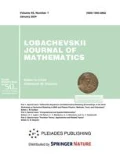Abstract
A new distribution, the zero-inflated negative binomial-exponential (ZINB-E) distribution, is proposed. It is a mixture of a point mass at zero and a negative binomial-exponential (NB-E) distribution. The ZINB-E is an alternative distribution for count data with extra zeros and over-dispersion. We apply the method of maximum likelihood estimation for estimating parameters of the proposed distribution, and derive some of its mathematical properties. We also apply the proposed distribution to fit real data sets that have an excess of zero-count data. The result shows that the ZINB-E distribution is the best model for fitting data compared to the zero-inflated Poisson and zero-inflated negative binomial distributions.



Similar content being viewed by others
REFERENCES
Y. Min and A. Agresti, ‘‘Random effect models for repeated measures of zero-inflated count data,’’ Stat. Model. 5, 1–19 (2005).
S. M. Mwalili, E. Lesaffre, and D. Declerck, ‘‘The zero-inflated negative binomial regression model with correction for misclassification: An example in caries research,’’ Stat. Methods Med. Res. 17, 123–139 (2008).
D. Lambert, ‘‘Zero-inflated Poisson regression, with an application to defects in manufacturing,’’ Technometrics 34, 1–14 (1992).
F. Famoye and K. P. Singh, ‘‘Zero-inflated generalized Poisson regression model with an application to domestic violence data,’’ J. Data Sci. 4, 117–130 (2006).
M. Greenwood and G. U. Yule, ‘‘An inquiry into the nature of frequency distributions representative of multiple happenings with particular reference to the occurrence of multiple attacks of disease or of repeated accidents,’’ J. R. Stat. Soc. 83, 255–279 (1920).
W. Rainer, Econometric Analysis of Count Data (Springer, Berlin, Germany, 2000).
H. H. Panjer and G. E. Willmot, ‘‘Finite sum evaluation of the negative binomial-exponential model,’’ Astin Bull. 12, 133–137 (1981).
S. A. Klugman, H. H. Panjer, and G. E. Willmot, Loss Models. From Data to Decisions, 5th ed. (Wiley, Hoboken, NJ, 2019).
E. Gomez-Deniz, J. M. Sarabia, and E. Calderin-Ojeda, ‘‘Univariate and multivariate versions of the negative binomial-inverse Gaussian distributions with applications,’’ Insurance Math. Econom. 42, 39–49 (2008).
H. Zamani and N. Ismail, ‘‘Negative binomial-Lindley distribution and its application,’’ J. Math. Stat. 6, 4–9 (2010).
C. Pudprommarat, W. Bodhisuwan, and P. Zeephongsekul, ‘‘A new mixed negative binomial distribution,’’ J. Appl. Sci. 12, 1853–1858 (2012).
S. Aryuyuen and W. Bodhisuwan, ‘‘The negative binomial-generalized exponential (NB-GE) distribution,’’ Appl. Math. Sci. (Ruse) 7, 1093–1105 (2013).
H. Akaike, ‘‘A new look at the statistical model identification,’’ in Selected Papers of Hirotugu Akaike (Springer, New York, 1974), pp. 716–723.
G. Schwarz, ‘‘Estimating the dimension of a model,’’ Ann. Stat. 6, 461–464 (1978).
T. B. Arnold and J. W. Emerson, ‘‘Nonparametric goodness-of-fit tests for discrete null distributions,’’ R J. 3, 34–39 (2011).
R Core Team, R: A Language and Environment for Statistical Computing. http://www.R-project.org. Accessed 2020.
M. Flynn and L. A. Francis, ‘‘More flexible GLMs zero-inflated models and hybrid models,’’ in Proceedings of the E-Forum of Casualty Actuarial Society, 2009, pp. 148–224.
J. K. Lindsey, Modelling Frequency and Count Data (Oxford Univ. Press, Oxford, UK, 1995).
ACKNOWLEDGMENTS
The first author would like to thank the College of Industrial Technology, King Mongkut’s University of Technology North Bangkok (KMUTNB) for financial support of this research.
Author information
Authors and Affiliations
Corresponding authors
Additional information
(Submitted by A. I. Volodin)
Rights and permissions
About this article
Cite this article
Bodhisuwan, R., Kehler, A. The Zero-inflated Negative Binomial-Exponential Distribution and Its Application. Lobachevskii J Math 42, 300–307 (2021). https://doi.org/10.1134/S1995080221020062
Received:
Revised:
Accepted:
Published:
Issue Date:
DOI: https://doi.org/10.1134/S1995080221020062




